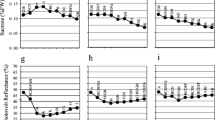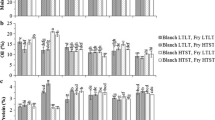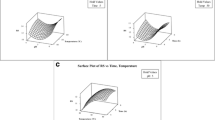Abstract
Control of the various processing operations is crucial for achieving optimal texture in french fries. This, in turn, requires precise measurement of the effect of each processing operation on the mechanical properties of the fries. A puncture test was used to measure the effects of blanching and freezing on peak force of french fry strips. Potatoes (cv. Russet Burbank) were grown at two locations in Manitoba in 1994 and 1995. Two blanching treatments (a 1-stage process, and a 2-stage process with a low-temperature long-time step) were followed by blast freezing. Strip position within the tuber was found to be a major source of variation for mechanical properties. Because peak force varied widely within and between tubers, it was necessary to compare the efficacy of the two blanching regimes using a pair of strips taken from as close a position as possible in the tuber. For both locations and crop years, blanched french fry strips taken from the pith of the tuber (referred to as inner strips), exhibited higher peak force than outer strips taken from the cortex. The 2-stage blanching process decreased the variation seen in the mechanical properties of different potato strips. Overall, strips blanched by the 2-stage process had significantly higher peak force than strips blanched by a single blanching process. The effect of blanching was evident in the mechanical properties of strips even after freezing and thawing. Microstructural analysis revealed that cells in the outer strips had a “balloon-like” appearance due to the degree of starch swelling pressure generated by swollen granules. For inner strips, this “balloon-like” appearance was less evident. Such appearance is in support of the starch swelling pressure hypothesis. The research shows that measurement of the effect of processing can be achieved by comparing treatments on adjacent strips in order to minimize variation between strips, and that a 2-stage blanching treatment can ameliorate texture differences between strips taken from different parts of the tuber.
Similar content being viewed by others
Literature Cited
Andersson, A., V. Gekas, I. Lind, F. Oliveira, and R. Öste. 1994. Effect of preheating on potato texture. Crit Rev Food Sci Nutr 34:229–251.
Anzaldúa-Morales, A., M.C. Bourne, and I. Shomer. 1992. Cultivar, specific gravity and location in tuber affect puncture force of raw potatoes. J Food Sci 57:1353–1356.
Artschwager, E. 1924. Studies on the potato tuber. J Agric Res 27:809–835.
Bourne, M.C. 1965. Studies on punch testing of apples. Food Technol 19:413–415.
Böhder, G., F. Escher, and J. Solms 1987. Evaluation of cooking quality of potatoes using sensory and instrumental methods. 2. Instrumental evaluation. Lebensm-Wiss & Technol 20:207–216.
Canet, W., J. Espinosa, and M.R. Altisent. 1984. Effects of the stepwise blanching on the texture of frozen potatoes measured by mechanical tests. Science et Tech du froid 284–289.
Dean, B.B. and R.E. Thornton. 1992. The specific gravity of potatoes. Ext Bull Wash State Univ Coop Ext Serv, Pullman, WA.
Fedec, P., B. Ooraikul, and D. Hadziyev. 1977. Microstructure of raw and granulated potatoes. Can Inst Food Sci Technol J 10:295–306.
Fennema, O. 1989. Freezing Preservation in: Principles of Food Science. Part I. Physical Principles of Food Preservation. Pages 173–211. O.R. Fennema ed. Marcel Dekker, Inc. New York, NY.
Freeman, M., M.C. Jarvis, and H.J. Duncan. 1992. The textural analysis of cooked potato. 3. Simple methods for determining textures. Potato Res 35:103–109.
Fuchigami, M., K. Miyazaki, and N. Hyakumoto. 1995a Frozen carrots texture and pectic components as affected by low-temperature-blanching and quick freezing. J Food Sci 60:132–136.
Fuchigami, M., N. Hyakumoto, and K. Miyazaki. 1995b. Texture and pectic composition differences in raw, cooked and frozen-thawed Chinese cabbages due to leaf position. J Food Sci 60:153–156.
Haydar, M., K. Moledina, B. Ooraikul, and D. Hadziyev. 1980. Effect of calcium and magnesium on cell wall and starch of dehydrated potato granules. J Agric Food Chem 28:383–391.
Hoover, R. and D. Hadziyev. 1981. Characterization of potato starch and its monoglyceride complexes. Starch 33:290–300.
Iritani, W.M., M.J. Powers, L. Hudson, and L. Weller 1977. Factors influencing time to breakdown (TTB) of cooked potato tissue. Am Potato J 54:23–32.
Jarvis, M.C. and H.J. Duncan 1992. The textural analysis of cooked potato. 1. Physical principles of the separate measurement of softness and dryness. Potato Res 35:83–91.
Jarvis, M.C., E. Mackenzie, and H.J. Duncan. 1992. The textural analysis of cooked potato. 2. Swelling pressure of starch during gelatinization. Potato Res 35:93–102.
Kawabata, A., S. Sawayama, N. Nagashima, and Y. Shimada. 1976. A study of textural changes in french fried potatoes as a result of freezing. J Agric Sci [Tokyo] 20:213–224.
Linehan, D.J. and J.C. Hughes. 1969. Texture of cooked potato II.-Relationships between intercellular adhesion and chemical composition of the tuber. J Sci Food Agric 20:113–119.
Lingle, R. 1988. 21st century processing at Carnation’s frozen potato plant. Prepared Foods 157(5):86–91.
Mohr, W.P. 1972. Soggy-centered french fries. Can Inst Food Sci Technol J 5:179–183.
Pritchard, M.K. and L.R. Adam. 1992. Preconditioning and storage of chemically immature Russet Burbank and Shepody potatoes. Am Potato J 69:805–815.
Reeve, R.M. 1967. A review of cellular structure, starch and textural qualities of processed potatoes. Econ Bot 21:294–308.
Reeve, R.M., E. Hautala, and M.L. Weaver. 1970. Anatomy and compositional variations within potatoes III. Gross compositional gradients. Am Potato J 47:148–162.
Sayre, R.N., M. Nonaka, and M.L. Weaver. 1975. French fry quality related to specific gravity and solids content variation among potato strips within the same tuber. Am Potato J 52:73–82.
Sharma, M.K., D.R. Isleib, and S.T. Dexter. 1958. Specific gravity of different zones within potato tubers. Am Potato J 35:784–788.
Sharma, M.K., D.R. Isleib, and S.T. Dexter. 1959. The influence of specific gravity and chemical composition on hardness of potato tubers after cooking. Am Potato J 36:105–112.
Steinbuch, E. 1976. Improvement of texture of frozen vegetables by step-wise blanching treatments. J Food Technol 11:313–316.
Author information
Authors and Affiliations
Corresponding author
Rights and permissions
About this article
Cite this article
Agblor, A., Scanlon, M.G. Effects of blanching conditions on the mechanical properties of french fry strips. Am. J. Pot Res 75, 245–255 (1998). https://doi.org/10.1007/BF02853603
Accepted:
Issue Date:
DOI: https://doi.org/10.1007/BF02853603




